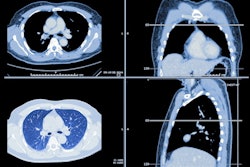Dear AuntMinnie CT Insider,
Adding deep learning to CT imaging to assess changes in subcutaneous adipose tissue (SAT) over time could help predict outcomes among individuals vulnerable to lung cancer, according to research presented at the recent RSNA meeting.
A German team developed a deep learning model for automatic 3D quantification of adipose tissue on low-dose chest CT and assessed any associations between this tissue and mortality among a population of heavy smokers at high risk of lung cancer who participated in screening. What did they discover? Check out our featured article to find out.
After you've read that story, navigate over to our CT content area for more coverage of the modality, including a plethora of presentations delivered at the recent RSNA meeting.
- Mayo Clinic researchers shared results from a study that quantified cardiac CT and cardiac MRI use trends over the past seven years -- and their findings may surprise you.
- A group from Brigham and Women's Hospital in Boston found that at least 15% of surgeries patients undergo after lung cancer screening are performed on benign lesions.
- French investigators discussed research findings that showed how photon-counting CT (PCCT) effectively visualizes pulmonary embolism (PE) and reduces the radiation dose by 48% compared to traditional CT, while another team found that chest PCCT bests conventional CT when it comes to improving the contrast-to-noise ratio of vascular structures.
- A team from Vanderbilt University Medical Center in Nashville, TN, shared how coordinating lung cancer and mammography screening boosts uptake of the former.
- Another group presented study results that showed how an automated AI algorithm designed to opportunistically screen for cardiomegaly on routine chest and abdominal CT exams effectively predicted future cardiovascular events.
- A team from Jefferson Health in Philadelphia, PA, found that a CT-guided procedure called a stellate ganglion block shows promise for restoring the sense of smell in patients with long COVID.
Also take a look at our coverage of a study published in the Journal of Cardiothoracic Surgery that suggested that 3D reconstruction of CT images could aid in follow-up strategies for pulmonary nodule screening, as well as a guideline published in the Canadian Medical Association Journal that offers a framework for determining whether older adults who have fallen need CT imaging.
Finally, we're highlighting a large study published in November that underscored the value of low-dose CT (LDCT) for diagnosing early-stage lung cancer -- which translates to a 20-year survival rate of 81%.
Stay current on CT's many uses and innovations by visiting out our CT content area often, and if you have CT-related topics you'd like us to consider, please contact me.




















